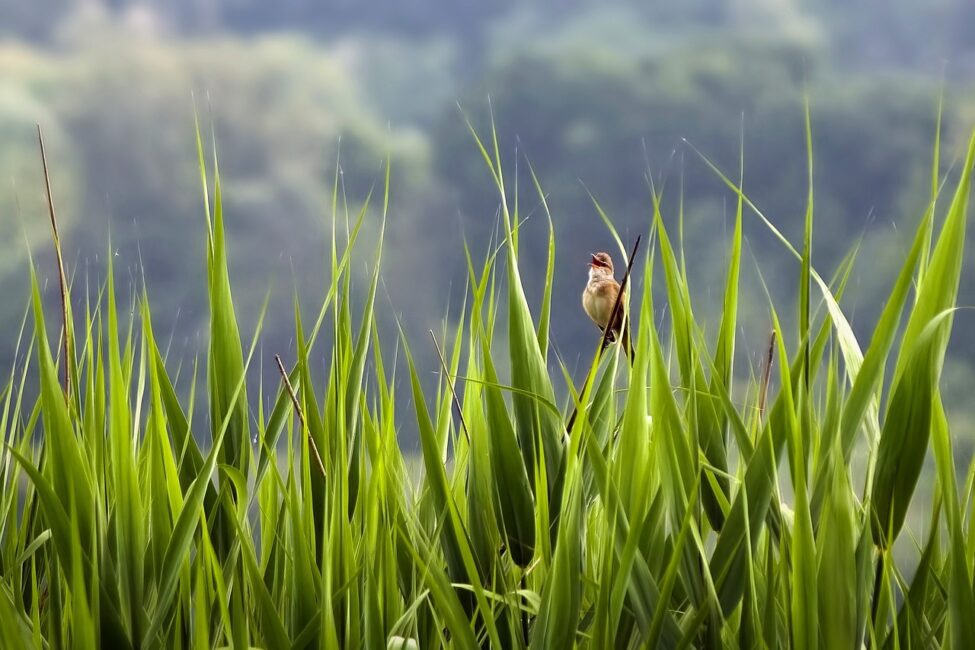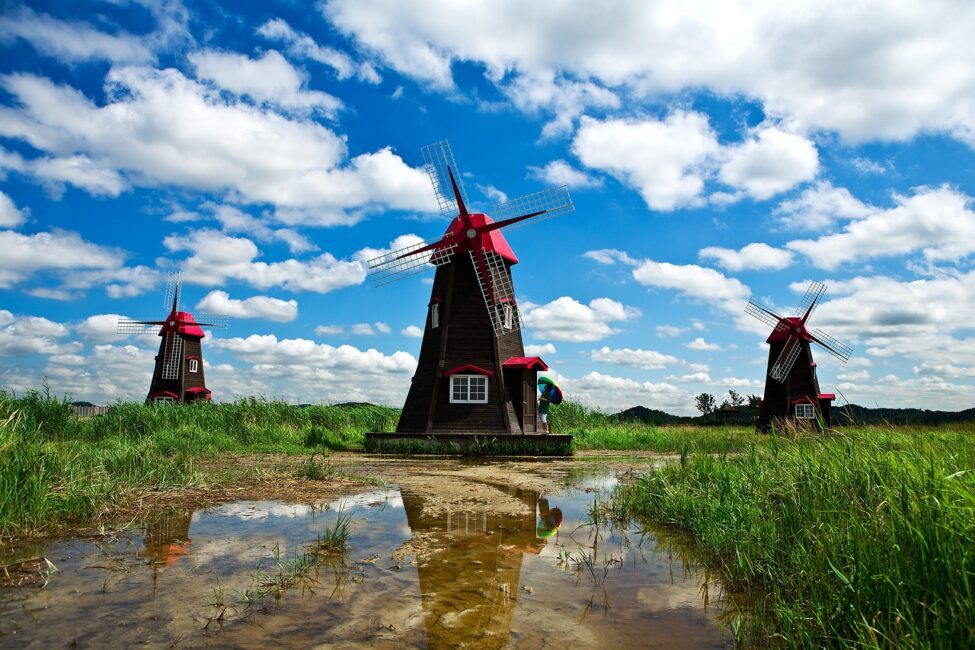Swamp Grass, scientifically known as “Schoenoplectus spp.,” is a type of grass that grows in wet and marshy areas. It’s a fascinating grass with unique characteristics that allow it to thrive in its watery habitat.
Swamp Grass belongs to a group of plants known as sedges, which are different from grasses and rushes. These plants have slender, grass-like leaves and produce distinctive clusters of flowers. The stem of Swamp Grass is usually triangular in shape, which helps it remain sturdy in the soft and muddy soil of its swampy home.
One of the most remarkable features of Swamp Grass is its adaptability to wet environments. It has specialized structures that enable it to grow and survive in waterlogged conditions. The plant’s roots help anchor it in the muddy substrate, preventing it from being swept away by water currents. Additionally, Swamp Grass has a unique way of obtaining oxygen. It possesses air channels in its stem, allowing oxygen to reach its underground parts, even when submerged in water.
The leaves of Swamp Grass play a crucial role in its survival. They are equipped with a waxy coating that prevents excess water from being absorbed, which could otherwise lead to the plant becoming waterlogged. This adaptation helps maintain the right balance of water for the plant’s growth and overall health.
Swamp Grass also serves important ecological functions within its habitat. Its dense growth provides shelter and nesting sites for various aquatic and bird species. The plant’s root systems help stabilize the soil, preventing erosion and creating a more stable environment for other organisms. Moreover, Swamp Grass acts as a natural filter, purifying the water by absorbing excess nutrients and pollutants.
In some cases, Swamp Grass has historical significance too. Indigenous communities have used parts of the plant for various purposes. For example, the stems can be woven into baskets, mats, and even used for thatching roofs. The plant’s seeds and rhizomes are a source of food for certain wildlife species.
In addition, Swamp Grass is a remarkable grass plant with unique adaptations that allow it to thrive in wetland environments. Its ability to survive in waterlogged conditions, its triangular stem, and its waxy-coated leaves are all fascinating traits. Beyond its survival strategies, Swamp Grass plays a crucial role in maintaining the health of its ecosystem by providing habitat, stabilizing soil, and filtering water. So, the next time you come across Swamp Grass, take a moment to appreciate its extraordinary features and its importance in the intricate web of life within swamps and wetlands.
Read Also: Strawberry Petioles: Economic Importance, Uses and By-Products
Growing and Care Guide of Swamp Grass

Growing and caring for Swamp Grass can be a rewarding endeavor, especially if you have a wet or marshy area in your garden or property. Follow these simple steps to successfully cultivate and maintain this unique plant:
1. Choosing the Right Location: Swamp Grass thrives in wet and marshy areas with consistently moist soil. Select a spot that receives ample sunlight, as this will help the plant grow vigorously. Avoid areas prone to excessive dryness.
2. Preparing the Soil: While Swamp Grass can tolerate waterlogged conditions, it’s essential to ensure good drainage to prevent water from stagnating around the roots. You can improve drainage by adding organic matter such as compost to the soil.
3. Planting: If you’re starting with Swamp Grass seeds or young plants, plant them during the growing season. Make a small hole in the soil and place the seed or plant, then cover it with soil. Space the plants according to their mature size, as they can grow quite large.
4. Watering: Keep the soil consistently moist but not waterlogged. During the initial stages of growth, regular watering is essential to help the plant establish its root system. Once established, it should be able to get sufficient moisture from the surrounding environment.
5. Mulching: Apply a layer of mulch around the base of the Swamp Grass to help retain soil moisture and prevent weeds from growing. This is particularly important during the early stages of growth.
6. Fertilizing: Swamp Grass doesn’t typically require heavy fertilization. However, you can provide a balanced, slow-release fertilizer during the growing season to promote healthy growth.
7. Pruning: While Swamp Grass doesn’t need extensive pruning, you can trim away any dead or damaged foliage to keep the plant looking neat. This also allows for better air circulation around the plant.
8. Dividing: Over time, Swamp Grass can spread and form dense clumps. To prevent overcrowding and promote healthier growth, consider dividing the clumps every few years. Dig up the clump, separate the individual plants, and replant them in suitable spots.
9. Pest and Disease Control: Generally, Swamp Grass is relatively resistant to pests and diseases. However, keep an eye out for any signs of trouble, such as discoloration or wilting. Address issues promptly to prevent them from spreading.
10. Winter Care: Depending on your climate, Swamp Grass may die back in the winter or remain evergreen. If your area experiences frost, the plant might die back and regrow in the spring. Mulching around the base can help protect the roots during colder months.
Remember that Swamp Grass is an important part of wetland ecosystems, so if you’re cultivating it in a natural area, be mindful of its role in supporting local wildlife and maintaining the ecological balance. With proper care and attention, you can enjoy the beauty and benefits of Swamp Grass while contributing to the health of your garden or property’s wetland environment.
Read Also: Essential Characteristics of Soils
Benefits and Uses of Swamp Grass

Swamp Grass, with its unique characteristics and adaptability, offers several benefits and diverse uses. Here are some of them:
1. Erosion Control: The dense root systems of Swamp Grass help stabilize soil in wetland areas, preventing erosion caused by water currents. Planting Swamp Grass can contribute to the protection of shorelines and the preservation of sensitive habitats.
2. Water Filtration: Swamp Grass plays a crucial role in water purification. Its roots and leaves act as natural filters, absorbing excess nutrients and pollutants from the water. This helps improve water quality and maintain a healthier aquatic environment.
3. Habitat for Wildlife: The dense growth of Swamp Grass provides valuable habitat and nesting sites for various aquatic and bird species. These plants offer shelter and protection, contributing to the biodiversity of wetland ecosystems.
4. Carbon Sequestration: Wetlands, including those populated by Swamp Grass, are excellent carbon sinks. They store carbon dioxide from the atmosphere, helping mitigate the effects of climate change.
5. Traditional Uses: Indigenous communities have historically utilized different parts of Swamp Grass for various purposes. The stems can be woven into baskets, mats, and other crafts. Additionally, the plant’s seeds and rhizomes serve as a food source for some wildlife species.
6. Wetland Restoration: When restoring or creating wetland habitats, planting Swamp Grass can be an integral part of the process. Its ability to thrive in waterlogged conditions contributes to the successful establishment of a balanced ecosystem.
7. Aesthetic Value: Swamp Grass can add a unique and visually appealing element to landscapes, especially those with wet or marshy areas. Its slender leaves, distinctive clusters of flowers, and overall form can enhance the natural beauty of the surroundings.
8. Educational Tool: Swamp Grass can serve as an educational resource, especially in school or nature center settings. Studying the plant’s adaptations and ecological role can help people better understand the importance of wetland ecosystems.
9. Research and Conservation: Scientists often study Swamp Grass and other wetland plants to gain insights into ecosystem dynamics, water quality, and biodiversity. Such research contributes to conservation efforts and the preservation of wetland areas.
10. Biodiversity Promotion: By creating suitable conditions for Swamp Grass to grow, you’re fostering a diverse array of organisms that depend on wetland habitats. This contributes to overall biodiversity and the health of ecosystems.
Incorporating Swamp Grass into wetland restoration projects, landscaping, or natural area conservation efforts can have far-reaching positive impacts. Its ability to provide ecosystem services, support wildlife, and contribute to the beauty of landscapes showcases the importance of preserving and nurturing these unique habitats.
Read Also: E-Waste: Complete Guide to Properly Dispose your Electronic Wastes
